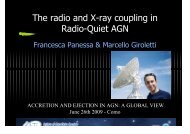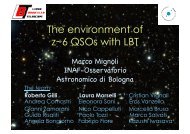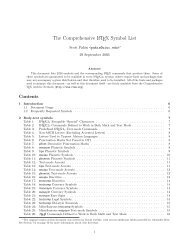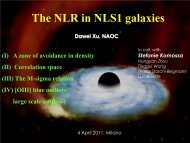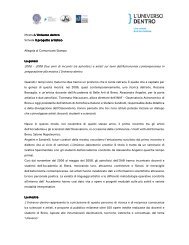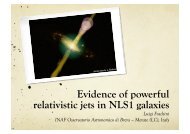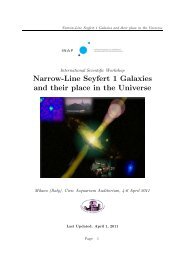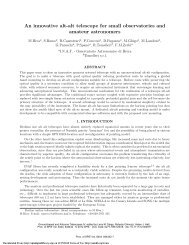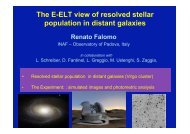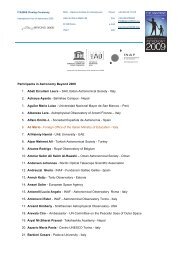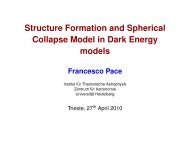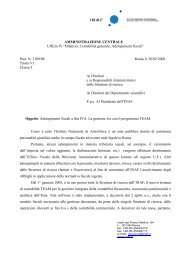<strong>IASF</strong> <strong>Roma</strong> - STATUS REPORTfor the Visiting CommitteeRef: <strong>IASF</strong>-RM-VC-001/07DATA: 19 November 2007Page: 26/134Bologna. Important developments of this research will be possible with GLAST observations inthe gamma-ray range that will launched in 2008.XMM observations of AG Draconis: ViottiSpace (XMM) and ground-based (Asiago, Loiano, TNG, amateurs) monitoring have beensecured of the supersoft/symbiotic system AG Dra and many outbursts have been studied indetails. The XMM observations during 2003-2006 confirmed the high X-ray luminosity duringquiescence, 2-3e5 L(sun), and marked the deep X-ray decrease during outburst when the OM-UV and visual luminosities brighten up. The observations indicate that during outburst anextended hot envelopeis formed opaque to higher energy photons. Evidence is also given for the presence all the timeof a high-energy 05-0.6 keV excess.GLAST, The Gamma-Ray Large Area Space Telescope: P. Ubertini, MT. Fiocchi, A. Galli,L.Piro,M.TavaniThe GLAST mission is an astrophysics & particle physics Space Laboratory, led by NASA withan important contributions from Italy (ASI). The main scientific objective is to study the“energetic” Universe looking at objects that emit high energy photons in the energy range10MeV - 300GeV, complemented with a Gamma Ray Burst Minitor. The key scientific objectivesof GLAST are 1) to understand the mechanisms of particle acceleration in AGNs, pulsars, andSNRs; 2) to resolve the γ-ray sky: unidentified sources and diffuse emission; 3) to determine thehigh-energy behavior of gamma-ray bursts and transients and 4) to probe dark matter and earlyUniverse. Unveiling the nature of a vast number of unidentified sources is the most compellingproblem facing today’s high-energy (MeV-to-GeV) γ-ray astronomy. <strong>IASF</strong> <strong>Roma</strong> participate tothe GLAST science with a programme dedicated to the identification of unknown γ-Raysources with a robust multi-wavelength programme conducted in collaboration with <strong>IASF</strong>Milano and <strong>IASF</strong> Bologna. Main inputs will be the large INTEGRAL Survey data base,SWIFT-XRT high resolution imaging and INTEGRAL/AGILE-GLAST simultaneousobservations dedicated to Blazars physics.XEUS: E. Costa, L. Piro, P. SoffittaIt is a great observatory aimed to combine a very large collecting area (5m 2 @) 1 keV, 2m 2 @) 7keV, 0.1 m 2 @) 30 keV ) with a reasonably good angular resolution (
<strong>IASF</strong> <strong>Roma</strong> - STATUS REPORTfor the Visiting CommitteeRef: <strong>IASF</strong>-RM-VC-001/07DATA: 19 November 2007Page: 27/134structures and the nucleosynthesis. It will study as well the properties of matter in extremegravitational and magnetic fields.<strong>IASF</strong>-<strong>Roma</strong> and INFN-Pisa will contribute the polarimeter, and, under dutch leadership,has a role in the development of TES detector.GRI, A Focussing Gamma Ray Imager Exploring the Extremes: L. Natalucci, A. Bazzano,G. De Cesare, A. De Rosa, S. Di Cosimo, M. Frutti, P. UbertiniMany fundamental questions of modern astrophysics are related to the extremes of ourUniverse: extreme energies that drive powerful stellar explosions and accelerate particles tomacroscopic energies, extreme densities that modify the laws of physics around the mostcompact objects known, and extreme fields that influence the matter in a way that isunexplorable on Earth. The importance of understanding these extremes has been stressed inthe ESA Cosmic Vision plan. The Gamma-Ray Imager (GRI) will explore these extremes viafocused observations in the hard X-ray and soft γ-ray bands. For the first time ever in thisdomain, focusing technologies will be employed to concentrate high-energy photons onto asmall focal spot. Focusing will bring the long awaited sensitivity leap, lifting the veil of theextreme Universe. GRI will bring a sensitivity leap in an energy band where non-thermalprocesses start to dominate over thermal ones and provide unprecedented information aboutcosmic particle accelerators and cosmic explosions that shape the evolving violent Universe.The GRI project has been developed by a large international consortium lead by Italy (Co-PI: Angela Bazzano, <strong>INAF</strong>/<strong>IASF</strong>-<strong>Roma</strong> and F. Frontera, UNIFE) and France (Co-PI: J.Knödlseder and P. von Ballmoos CESR) with main contribution from Danmark, Spain and USA.EDGE: L. Piro, A. Corsi, M. Cocchi, L. Colasanti, M. Del Santo, A. De Rosa, S. Di Cosimo,M. Frutti, A. Galli, L., B. Gendre, Natalucci, C. Macculi, P. UbertiniHow structures on various scales formed and evolved from the early Universe up to presenttime is a fundamental question of astrophysical cosmology. EDGE will trace the cosmic historyof the baryons from the early generations of massive star by Gamma-Ray Burst (GRB)explosions, through the period of cluster formation, down to very low redshifts, when between athird and one half of the baryons are expected to reside in cosmic filaments undergoinggravitational collapse by dark matter (Warm Hot Intragalactic Medium: WHIM). In additionEDGE, with its unprecedented observational capabilities, will provide key results on severalother topics. The science is feasible with a medium class mission using existing technologycombined with innovative instrumental and observational capabilities on a single satellite by: a)observing with fast reaction Gamma-Ray Bursts with a high spectral resolution (R ~ 500). Thisenables the study of their (star-forming) environment from the Dark to the local Universe andthe use of GRB as back light of large scale cosmological structures b) Observing and surveyingextended sources (clusters, WHIM) with high sensitivity using two wide field of view X-raytelescopes (one with a high angular resolution and the other with a high spectral resolution).The mission is based on a well balanced instrument complement, that includes – among others– instruments under development in our institute: TES microcalorimeters for high resolutionspectroscopy, and a wide field monitor. The proposal to ESA CV, EDGE (Explorer of theDiffuse emission and GRB Explosion: L. Piro et al., is now evolving into a proposal to NASAfor the recent call for mission conceptsX-RAY POLARIMETRY: E. Costa, S. Di Cosimo, E. Morelli, F. Muleri, A. Rubini, P. SoffittaWhile techniques for imaging, photometry and spectroscopy, through numerous X-rayAstronomy missions, from UHURU to SUZAKU and in view of future observatories, havearrived an excellent development, polarimetry has played, so far, a relatively marginal role.This in spite of an extended theoretical literature that identifies Polarimetry as a powerfuldiagnostic tool for physics and geometry of emitting regions. This is mainly due to low sensitivityand cumbersomeness of conventional techniques (Bragg at 45° and Compton/Thomson at 90°).27



